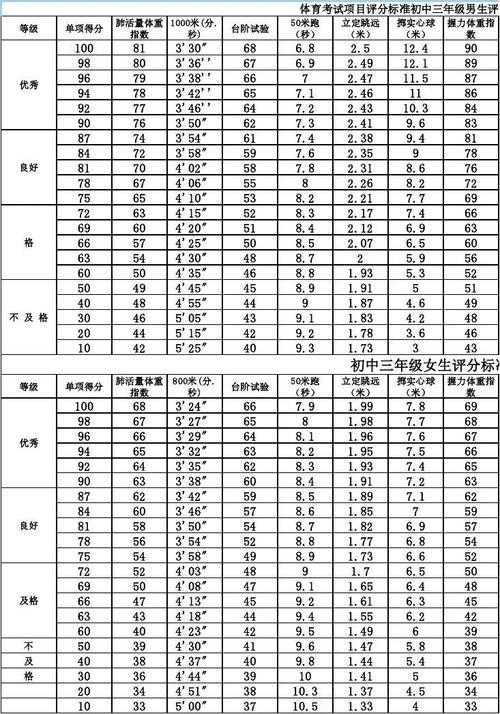初三体育中考跳绳标准成绩
Title: Understanding Physical Education Standards for Middle School Students
Physical education (PE) standards for middle school students play a crucial role in fostering physical fitness, skill development, and overall wellbeing. These standards are designed to ensure that students acquire essential knowledge and skills in various physical activities. Let's delve into the typical standards and expectations for middle school PE:
Components of PE Standards:
1.
Physical Fitness:
Middle school PE standards often emphasize the development of physical fitness through activities such as running, jumping, flexibility exercises, and strength training.
Students are expected to demonstrate improvements in cardiovascular endurance, muscular strength, flexibility, and body composition over time.
2.
Skill Development:
PE curriculum focuses on teaching fundamental movement skills such as running, jumping, throwing, catching, and striking.
Middle school students are guided to refine these skills and learn more advanced techniques in sports like basketball, soccer, volleyball, and others.
3.
Health Education:
In addition to physical activities, PE standards incorporate health education components covering topics like nutrition, injury prevention, personal hygiene, and the importance of physical activity for overall health.
Students learn about the benefits of leading an active lifestyle and making healthy choices.
4.
Sportsmanship and Cooperation:
PE standards often emphasize the importance of sportsmanship, fair play, and cooperation in team sports and group activities.
Students are encouraged to demonstrate respect for teammates, opponents, coaches, and officials while participating in various sports and games.
Guidelines for Middle School PE:
1.
Structured Physical Activities:
PE classes should provide a balanced mix of structured physical activities, including individual skill practice, team sports, fitness circuits, and recreational games.
Teachers should vary activities to cater to different interests and abilities, ensuring engagement and participation from all students.
2.
Progressive Curriculum:
The curriculum should be progressive, building upon previously acquired skills and knowledge while introducing new challenges.
Teachers should assess students' abilities periodically and adjust instruction accordingly to support individual growth and development.
3.
Inclusive Approach:
Middle school PE programs should adopt an inclusive approach that accommodates students of varying abilities and backgrounds.
Teachers should provide modifications and adaptations to ensure that all students can participate and experience success.
4.
Safety Measures:
Safety is paramount in PE classes. Teachers must ensure that equipment is properly maintained, and students are instructed on safe techniques and practices to prevent injuries.
Supervision and proper warmup and cooldown routines are essential to minimize the risk of accidents during physical activities.
Recommendations for Success:
1.
Encourage Active Participation:
Teachers should create a supportive and encouraging environment that motivates all students to actively participate in PE activities.
Incorporating elements of fun, teamwork, and competition can enhance engagement and enjoyment.
2.
Provide Positive Feedback:
Offering constructive feedback and praise for effort and improvement can boost students' confidence and selfesteem.

Recognizing individual achievements and progress fosters a positive learning atmosphere.
3.
Promote Lifelong Fitness:
Middle school PE programs should aim to instill a love for physical activity and fitness that extends beyond the classroom.
Teachers can encourage students to pursue extracurricular sports or recreational activities outside of school to maintain an active lifestyle.
4.
Collaborate with Parents:
Regular communication with parents regarding students' progress and participation in PE can foster collaboration between home and school.
Encouraging parental involvement in promoting physical activity and healthy habits reinforces the importance of PE standards.
In conclusion, middle school PE standards encompass a comprehensive approach to physical fitness, skill development, health education, and sportsmanship. By following guidelines and recommendations, educators can effectively promote the wellbeing and lifelong fitness of their students.



